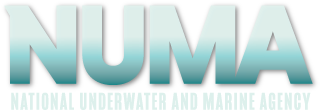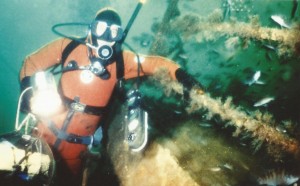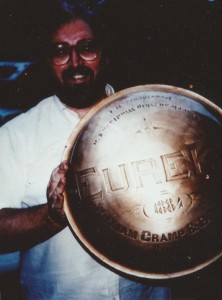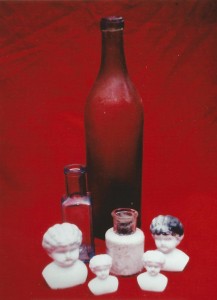Virginia Shipwreck Yields Fascinating Cargo
What would you do if you discovered a ship that sank in 1888 loaded with china dolls, cut glass, brass fittings and other cargo destined for New Orleans and the Western Movement of early settlers in America? You might want to shout, “Eureka! I’ve found it!” But Capt. Mike Boring of Virginia Beach, Virginia, didn’t shout for joy until later when he found out his virgin wreck was the Eureka, an American schooner that collided with the British steamship, Benison, 58 miles southeast of Cape Henry, Virginia.
With help from Bill Hughes of State College, Pennsylvania, Boring pieced together the fascinating history of the four-masted, square-rigged ship whose massive single cylinder reciprocal steam engine rises 20 feet off the bottom from depths of 95 to 115 feet. Built in Philadelphia in 1884, the Morgan Line schooner was agile and economical, plying the waters for four years between New York and New Orleans. It was on this route in a dense fog that the Eureka took a severe hit on its starboard side from the Benison whose captain had ignored the navigational Rules of the Road. When his ship caught fire and started to list, Capt. Robert Quick ordered all hands to the lifeboats. As the fog lifted, they watched the steamship, Hudson, whose lookout spotted the ships in distress, tow the Benison away. Another vessel, the Carolyn Gray, was sailing the same route and rescued the captain and crew of the doomed vessel. Fortunately, there were no causalities.
Had it not been for Capt. Robert Hollowell, a commercial fisherman and friend of Capt. Boring’s, the Eureka might still rest undetected on the bottom of the ocean. “I’ve been on most of the Virginia Beach wrecks,” Boring said, “so I thought I’d check out my friend’s loran numbers that identified an underwater obstruction. I had no idea I would find a 350-foot 19th century schooner with much of its cargo intact.”
Research revealed that commercial hardhat divers from a salvage company in Norfolk retrieved some barrels of flour from the forward hold, but little else. The Atlantic Mutual Insurance Company paid a $160,000 claim to the ship’s owners. The divers, not interested in the remaining cargo, dynamited the masts to clear the area for safe navigation. Boring and his buddies used ping-pong paddles to fan the sand and uncover their elusive “treasures.”
Boring compared it to diving in a general hardware store at the turn of the century. Ax heads, tools, grindstones and fire hoses with brass fittings were some of the first discoveries. Then came dinnerware, cut glass inkwells, tea sets, shoes, a gold watch and bottles of cognac. But the best came last: hundreds of arms, legs and heads of china dolls, all clumped together in the sand, their wooden crates rotted away. These late 1800 china dolls were put together in homes of the early settlers who used needles and thread to sew the parts on a muslin body that then became a finished doll ready to costume. The collectible doll parts helped shed light on the age of the ship later identified when Boring discovered the brass capstan cover with the ship’s name and builder on it.
Bill Hughes sums it up best when he says, “Diving the Eureka is like going back in time and rummaging through a combination hardware, department, liquor and toy store. The best part is toasting to our day of shopping with a glass of 122-year-old cognac.”
8 Comments
Submit a Comment
All Rights Reserved © | National Underwater and Marine Agency
All Rights Reserved © | National Underwater and Marine Agency
Web Design by Floyd Dog Design
Web Design by Floyd Dog Design




I am very interested to learn about ship wrecks, artifacts, history of and so on. Please contact me
Oh good, there’s a lot out there to read and study and research. I received your email and will contact you. E.
I have a tool that may have come from this ship wreck. I just don’t remember much about the occasion that I came about getting it.
I know whoever it was told me it was from a sunken ship. It a very rusty tool.
This was over 20 years ago.
Can anyone address my previous comment?
Since I was just told that I had sent this message, or one
similar, before!
Samantha: I don’t remember any message from you. Could you send it again?
Send it to Numa.net and to my personal email: ellsboyd@aol.com. Many thanks.
Samantha: Take a picture of this tool and send it to: Duncan Mathewson at: reddog1690@aol.com
He was Mel Fisher’s archaeologist and is very good at identifying early times artifacts from shipwrecks. Give him as much information as you can. When and where did you get it? What shipwreck do you THINK it might have come from, and anything else you can think of.
Eli Bros liniment, snuff bottles, gherkin pickles, Piso’s cure, Maltine, St John’s apothecary, look in the bow for rolls of handmade lace.
Greg: What interesting finds. It is amazing that the lace didn’t rot away. Tell us a little bit about your dive or dives on this wreck. Cheers, Ellsworth